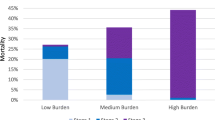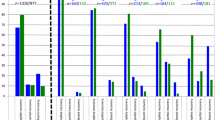Abstract
Purpose
To quantify the error in evaluating recovery from acute kidney injury (AKI) with estimated GFR (eGFR) in relation to ICU stay.
Methods
Secondary analysis performed on the database of the EPaNIC trial. In a cohort of patients who developed AKI during ICU stay we compared eGFR with measured creatinine clearance (Clcr) at ICU discharge. Recovery of kidney function was assessed by comparison with baseline eGFR and the accuracy of eGFR to detect “potential CKD status” defined by Clcr was quantified. The same analysis was performed in subgroups with different ICU stay. Multivariate regression was performed to determine independent predictors of the eGFR–Clcr difference.
Results
A total of 757 patients were included. The bias (limits of agreement (LOA)) between eGFR and Clcr at ICU discharge related to ICU stay, increasing from +1.3 (−37.4/+40) ml/min/1.73 m2 in patients with short stay to +34.7 (−54.4/+123.8) ml/min/1.73 m2 in patients with ICU stay of more than 14 days. This resulted in a significantly different incidence of complete recovery with the two evaluation methods and reduced sensitivity to detect “potential CKD status” with eGFR in patients with prolonged ICU stay. Independent predictors of the bias included creatinine excretion on the last day in ICU, baseline eGFR, ICU stay, gender, and age.
Conclusion
Compared to Clcr, discharge eGFR results in overestimation of renal recovery in patients with prolonged ICU stay and in reduced accuracy of “CKD staging”. Since age, gender and race do not change during ICU stay the same conclusion can be drawn with regard to plasma creatinine.


Similar content being viewed by others
References
Kidney Disease: Improving Global Outcomes (KDIGO) Acute Kidney Injury Work Group (2012) KDIGO clinical practice guidelines AKI: AKI definition. Kidney Intern Suppl 2:19–36
Stevens LA, Levey AS (2009) Measured GFR as a confirmatory test for estimated GFR. J Am Soc Nephrol 20:2305–2313
Macedo E, Mehta RL (2013) Measuring renal function in critically ill patients: tools and strategies for assessing glomerular filtration rate. Curr Opin Crit Care 19:560–566
Levey AS, Bosch JP, Lewis JB, Greene T, Rogers N, Roth D (1999) A more accurate method to estimate glomerular filtration rate from serum creatinine: a new prediction equation. Modification of Diet in Renal Disease Study Group. Ann Intern Med 130:461–470
Levey AS, Stevens LA, Schmid CH, Zhang YL, Castro AF 3rd, Feldman HI, Kusek JW, Eggers P, Van Lente F, Greene T, Coresh J, CKD-EPI (Chronic Kidney Disease Epidemiology Collaboration) (2009) A new equation to estimate glomerular filtration rate. Ann Intern Med 150:604–612
Harel Z, Wald R, Bargman JM, Mamdani M, Etchells E, Garg AX, Ray JG, Luo J, Li P, Quinn RR, Forster A, Perl J, Bell CM (2013) Nephrologist follow-up improves all-cause mortality of severe acute kidney injury survivors. Kidney Int 83:901–908
Levin A, Stevens PE (2011) Early detection of CKD: the benefits, limitations and effects on prognosis. Nat Rev Nephrol 7:446–457
Pannu N, James M, Hemmelgarn B, Klarenbach S, Network Alberta Kidney Disease (2013) Association between AKI, recovery of renal function, and long-term outcomes after hospital discharge. Clin J Am Soc Nephrol 8:194–202
Ali T, Khan I, Simpson W, Prescott G, Townend J, Smith W, Macleod A (2007) Incidence and outcomes in acute kidney injury: a comprehensive population-based study. J Am Soc Nephrol 18:1292–1298
Kopolovic I, Simmonds K, Duggan S, Ewanchuk M, Stollery DE, Bagshaw SM (2013) Risk factors and outcomes associated with acute kidney injury following ruptured abdominal aortic aneurysm. BMC Nephrol 14:99
Fortrie G, Stads S, de Geus HR, Groeneveld AB, Zietse R, Betjes MG (2013) Determinants of renal function at hospital discharge of patients treated with renal replacement therapy in the intensive care unit. J Crit Care 28:126–132
Macedo E, Zanetta DM, Abdulkader RC (2012) Long-term follow-up of patients after acute kidney injury: patterns of renal functional recovery. PLoS One 7:e36388
Stevens LA, Coresh J, Feldman HI, Greene T, Lash JP, Nelson RG, Rahman M, Deysher AE, Zhang YL, Schmid CH, Levey AS (2007) Evaluation of the modification of diet in renal disease study equation in a large diverse population. J Am Soc Nephrol 18:2749–2757
Rule AD, Larson TS, Bergstralh EJ, Slezak JM, Jacobsen SJ, Cosio FG (2004) Using serum creatinine to estimate glomerular filtration rate: accuracy in good health and in chronic kidney disease. Ann Intern Med 141:929–937
Udy AA, Morton FJ, Nguyen-Pham S, Jarrett P, Lassig-Smith M, Stuart J, Dunlop R, Starr T, Boots RJ, Lipman J (2013) A comparison of CKD-EPI estimated glomerular filtration rate and measured creatinine clearance in recently admitted critically ill patients with normal plasma creatinine concentrations. BMC Nephrol 14:250
Hoste EA, Damen J, Vanholder RC, Lameire NH, Delanghe JR, Van den Hauwe K, Colardyn FA (2005) Assessment of renal function in recently admitted critically ill patients with normal serum creatinine. Nephrol Dial Transplant 20:747–753
Bouchard J, Macedo E, Soroko S, Chertow GM, Himmelfarb J, Ikizler TA, Paganini EP, Mehta RL, Program to Improve Care in Acute Renal Disease (2010) Comparison of methods for estimating glomerular filtration rate in critically ill patients with acute kidney injury. Nephrol Dial Transplant 25:102–717
Martin JH, Fay MF, Udy A, Roberts J, Kirkpatrick C, Ungerer J, Lipman J (2011) Pitfalls of using estimations of glomerular filtration rate in an intensive care population. Intern Med J 41:537–543
Kirwan CJ, Philips BJ, Macphee IA (2013) Estimated glomerular filtration rate correlates poorly with four-hour creatinine clearance in critically ill patients with acute kidney injury. Crit Care Res Pract 2013:406075
Casaer MP, Langouche L, Coudyzer W, Vanbeckevoort D, De Dobbelaer B, Güiza FG, Wouters PJ, Mesotten D, Van den Berghe G (2013) Impact of early parenteral nutrition on muscle and adipose tissue compartments during critical illness. Crit Care Med 41:2298–2309
Puthucheary ZA, Rawal J, McPhail M, Connolly B, Ratnayake G, Chan P, Hopkinson NS, Padhke R, Dew T, Sidhu PS, Velloso C, Seymour J, Agley CC, Selby A, Limb M, Edwards LM, Smith K, Rowlerson A, Rennie MJ, Moxham J, Harridge SD, Hart N, Montgomery HE (2013) Acute skeletal muscle wasting in critical illness. JAMA 310:1591–1600
Wilson FP, Sheehan JM, Mariani LH, Berns JS (2012) Creatinine generation is reduced in patients requiring continuous venovenous hemodialysis and independently predicts mortality. Nephrol Dial Transplant 27:4088–4094
Casaer MP, Mesotten D, Hermans G, Wouters PJ, Schetz M, Meyfroidt G, Van Cromphaut S, Ingels C, Meersseman P, Muller J, Vlasselaers D, Debaveye Y, Desmet L, Dubois J, Van Assche A, Vanderheyden S, Wilmer A, Van den Berghe G (2011) Early versus late parenteral nutrition in critically ill adults. N Engl J Med 365:506–517
Bjornsson TD (1979) Use of serum creatinine concentrations to determine renal function. Clin Pharmacokinet 4:200–222
National Kidney Foundation (2002) K/DOQI clinical practice guidelines for chronic kidney disease: evaluation, classification, and stratification. Kidney disease outcome quality initiative. Am J Kidney Dis 39(suppl 2):S1–S246
Srisawat N, Murugan R, Lee M, Kong L, Carter M, Angus DC, Kellum JA, Genetic and Inflammatory Markers of Sepsis (GenIMS) Study Investigators (2011) Plasma neutrophil gelatinase-associated lipocalin predicts recovery from acute kidney injury following community-acquired pneumonia. Kidney Int 80:545–552
Alves SC, Tomasi CD, Constantino L, Giombelli V, Candal R, Bristot Mde L, Topanotti MF, Burdmann EA, Dal-Pizzol F, Fraga CM, Ritter C (2013) Hypomagnesemia as a risk factor for the non-recovery of the renal function in critically ill patients with acute kidney injury. Nephrol Dial Transplant 28:910–916
Prowle JR, Kolic I, Purdell-Lewis J, Taylor R, Pearse RM, Kirwan CJ (2014) Serum creatinine changes associated with critical illness and detection of persistent renal dysfunctin after AKI. Clin J Am Soc Nephrol 9:1015–1023
Mirahmadi MK, Byrne C, Barton C, Penera N, Gordon S, Vaziri ND (2003) Prediction of creatinine clearance from serum creatinine in spinal cord injury patients. Am J Kidney Dis 41:269–278
Sherman DS, Fish DN, Teitelbaum I (2003) Assessing renal function in cirrhotic patients: problems and pitfalls. Am J Kidney Dis 41:269–278
Doi K, Yuen PS, Eisner C, Hu X, Leelahavanichkul A, Schnermann J, Star RA (2009) Reduced production of creatinine limits its use as marker of kidney injury in sepsis. J Am Soc Nephrol 20:1217–1221
Ponte B, Felipe C, Muriel A, Tenorio MT, Liaño F (2008) Long-term functional evolution after an acute kidney injury: a 10-year study. Nephrol Dial Transplant 23:3859–3866
Schmitt R, Coca S, Kanbay M, Tinetti ME, Cantley LG, Parikh CR (2008) Recovery of kidney function after acute kidney injury in the elderly: a systematic review and meta-analysis. Am J Kidney Dis 52:262–271
Chawla LS, Eggers PW, Star RA, Kimmel PL (2014) Acute kidney injury and chronic kidney disease as interconnected syndromes. New Engl J Med 371:58–66
Baxmann AC, Ahmed MS, Marques NC, Menon VB, Pereira AB, Kirsztajn GM, Heilberg IP (2008) Influence of muscle mass and physical activity on serum and urinary creatinine and serum cystatin C. Clin J Am Soc Nephrol 3:348–354
Tetsuka S, Morita M, Ikeguchi K, Nakano I (2013) Utility of cystatin C for renal function in amyotrophic lateral sclerosis. Acta Neurol Scand 128:386–390
Pöge U, Gerhardt T, Stoffel-Wagner B, Klehr HU, Sauerbruch T, Woitas RP (2006) Calculation of glomerular filtration rate based on cystatin C in cirrhotic patients. Nephrol Dial Transplant 21:660–664
Herridge MS (2009) Legacy of intensive care unit-acquired weakness. Crit Care Med 37(10 Suppl):S457–S461
Perrone RD, Madias NE, Levey AS (1992) Serum creatinine as an index of renal function: new insights into old concepts. Clin Chem 38:1933–1953
Conflicts of interest
The authors declare that they have no conflicts of interest related to the subject of the study. GVdB, via the University of Leuven, receives structural research financing via the Methusalem program, funded by the Flemish Government (METH08/07) and holds an ERC Advanced Grant (AdvG-2012-321670) from the Ideas program of the EU FP7.
Ethical standard
This study is a secondary analysis of the EPaNIC trial, for which written informed consent was obtained from all patients or their designated representatives. The protocol of the EPaNIC trial was approved by the institutional review board of the participating centers and by the Belgian authorities.
Author information
Authors and Affiliations
Corresponding author
Additional information
Take home message: In patients with prolonged ICU stay, recovery of AKI is significantly overestimated when assessed with eGFR.
Electronic supplementary material
Below is the link to the electronic supplementary material.
134_2014_3487_MOESM1_ESM.docx
Supplementary material 1 (DOCX 25 kb) Fig. 1 electronic supplement. Bland–Altman analysis of the difference between Clcr and eGFR at ICU discharge a in all no-AKI patients, b in no-AKI patients with ICU stay less than 8 days, c in no-AKI patients with ICU stay between 8 and 14 days, d in no-AKI patients with ICU stay longer than 14 days. The continuous line represents bias and the dashed lines the limits of agreement
Rights and permissions
About this article
Cite this article
Schetz, M., Gunst, J. & Van den Berghe, G. The impact of using estimated GFR versus creatinine clearance on the evaluation of recovery from acute kidney injury in the ICU. Intensive Care Med 40, 1709–1717 (2014). https://doi.org/10.1007/s00134-014-3487-1
Received:
Accepted:
Published:
Issue Date:
DOI: https://doi.org/10.1007/s00134-014-3487-1




